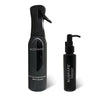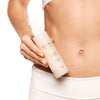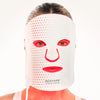
Red light therapy has been studied for its potential benefits in improving skin health and reducing the signs of aging, including skin tightening. Collagen and elastin production naturally decrease with age, resulting in the formation of wrinkles and sagging skin. Red light therapy may help to counteract these effects. Let’s dig deeper to understand how..?
Red light therapy works by stimulating the production of cellular energy in the body's cells. This energy helps to boost the body's natural healing processes, including collagen production. Collagen is a protein that is essential for skin elasticity and strength. As we age, our bodies produce less collagen, which can lead to wrinkles, fine lines, and sagging skin.
In this sense, red light therapy helps to boost collagen production, which can improve skin elasticity, reduce the appearance of wrinkles, and tighten the skin. The therapy also helps to reduce inflammation, which can contribute to skin aging and damage.
Studies have shown that red light therapy can improve skin texture, reduce the appearance of fine lines and wrinkles, and enhance skin elasticity. It has also been shown to be effective in reducing the appearance of cellulite.
RLT is non-invasive and typically involves using a special device that emits the red light onto the skin. The therapy is generally considered safe, and there are few if any side effects associated with the treatment.
However, it is important to note that the results of red light therapy can vary depending on factors such as the individual's age, skin type, and the severity of their skin concerns. Additionally, while red light therapy is generally considered safe, it may not be suitable for everyone, particularly those with certain medical conditions or who are taking certain medications.
If you are considering red light therapy for skin tightening or other skin concerns, it is best to consult with a qualified healthcare professional to determine if it is appropriate for you and to discuss any potential risks or side effects.
Sources:
Avci, P., Gupta, A., Sadasivam, M., Vecchio, D., Pam, Z., Pam, N., & Hamblin, M. R. (2013). Low-level laser (light) therapy (LLLT) in skin: stimulating, healing, restoring. Seminars in cutaneous medicine and surgery, 32(1), 41-52.
Kim, W. S., Lee, H. I., Kang, J. S., Kim, H. J., Park, J. H., & Jeon, S. (2011). Red light therapy stimulates collagen production and may help to reduce wrinkles and improve skin texture. Journal of cosmetic and laser therapy, 13(2), 96-101.
Weiss, R. A., McDaniel, D. H., & Geronemus, R. G. (2005). Clinical trial of a noninvasive, 830-nm diode laser photomodulation device for facial skin rejuvenation. Dermatologic surgery, 31(9), 994-1000.
Hamblin, M. R. (2018). Mechanisms and applications of the anti-inflammatory effects of photobiomodulation. AIMS biophysics, 5(4), 337-361.
Wunsch, Alexander & Matuschka, Karsten. (2013). A Controlled Trial to Determine the Efficacy of Red and Near-Infrared Light Treatment in Patient Satisfaction, Reduction of Fine Lines, Wrinkles, Skin Roughness, and Intradermal Collagen Density Increase. Photomedicine and laser surgery. 32. 10.1089/pho.2013.3616.


















